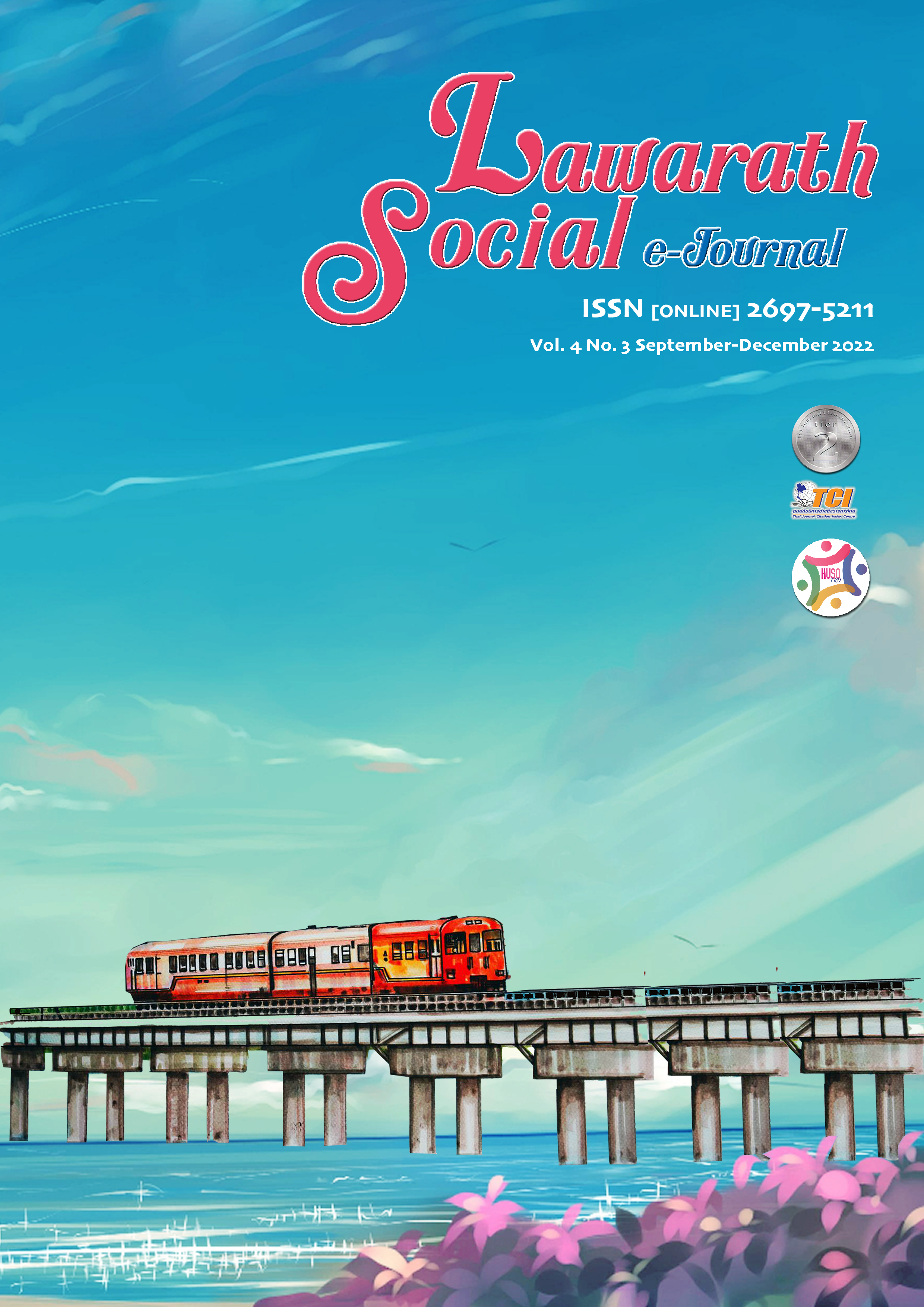The Development of Applied Exercise Activities Based on Local Wisdom to Enhance the Physical Fitness of the Elderly in Hua Phai Subdistrict, Mueang Singburi District, Singburi Province
Keywords:
Applied Physical Exercise Activity, Local Wisdom, Elders, Physical Fitness Test for ElderlyAbstract
The research aims to 1) design applied exercise activities based on local wisdom to help improve the physical fitness of the elderly and 2) to study the improvement of the elderly’s physical fitness in Hua Phai Subdistrict, Muang SingBuri District, SingBuri Province. The samples were 30 elderly aged between 60-69 years old who volunteered to join the study. They were divided into two groups. The Control group needed to do a basic exercise regularly, but the experimental group did the applied exercises based on local wisdom. The experiment group used a local loincloth to do a stretching activity as their first step of exercising. In the second step, they did an aerobic exercise with folk songs for 30-45 minutes per time and three times a week for six weeks. Both groups of participants were required to note down their results of five aspects of the physical fitness test for the elderly for example, weight, height, and body mass index measurement. They needed to do a back scratch test, a chair stand test for 30 seconds, an agility course test, and a 2-minute step-up and down test. Data were analyzed using mean, Independent Sample T-test, and standard deviation to compare the test data before and after the experiment. The reliability of the research instruments was assessed by the experts with the Index of Item Objective Congruence (IOC =1). The results showed that: 1) the community had a muscle stretching exercise activity using a local loincloth and also an aerobic exercise activity using folk songs; and 2) after 6 weeks of exercising, the experimental group’s average score on the agility course test was 12.13 (1.30)seconds. There was a statistically significant difference of .05 when compared to the control group which had an average score on the test of 19.20 (3.42) seconds. This indicates that the applied exercise has an effect on improving the elder’s agility. However, the data from other tests showed no statistical differences.
Downloads
References
คณิน ประยูรเกียรติ, และก้องสยาม ลับไพรี. (2563, กันยายน-ธันวาคม). การพัฒนาวิธีการออกกำลังกายตามแนวคิดภูมิปัญญาไทย เพื่อสร้างความสามารถในการทรงตัวของผู้สูงอายุ.วารสารวิชาการ มหาวิทยาลัยการกีฬาแห่งชาติ, 12(3), 96-109.
ชนิตา ไกรเพชร, อนันต์ เมฆสวรรค์, นิศานาถ เนตรบารมี, และอิ่นอ้อย เฉลิมชิต. (2560, มกราคม-เมษายน). ผลการใช้รูปแบบการออกกำลังกาย เพื่อส่งเสริมสุขภาพสำหรับผู้สูงอายุในกลุ่มจังหวัดภาคกลางโดยการมีส่วนร่วมของชุมชน. วารสารวิชาการ สถาบันการพลศึกษา, 9(1), 51-61.
เดลินิวส์. (2563, กันยายน, 6). รัฐบาลเตรียมแผนรับมือสังคมสูงวัย. สืบค้น สิงหาคม 26, 2565, จาก https://d.dailynews.co.th/politics/793792/.
ทิติภา ศรีสมัย, และคนอื่น ๆ (2560, พฤศจิกายน-ธันวาคม). ผลของการออกกำลังกายด้วยรำมวยโบราณประยุกต์ต่อสมรรถภาพทางกายในผู้สูงอายุชาวไทย: การศึกษานำร่อง. จุฬาลงกรณ์เวชสาร, 61(6), 745-755.
นันธวัช นุนารถ. (2560, มกราคม-เมษายน). ภูมิปัญญาท้องถิ่น คุณค่าแห่งวิถีชีวิต วัฒนธรรม เพื่อการศึกษาที่ยั่งยืน. วารสารวิชาการและวิจัยสังคมศาสตร์, 12(34), 16-17.
พัชรพล อ่อนสุระทุม. (2556). นวัตกรรมรำผ้าพลอง ทำนองสรภัญ ป้องกันโรค. สืบค้น สิงหาคม 20, 2565, จาก http://www.thatthong-sk.go.th/files/dynamiccontent/file-25069.pdf.
มูลนิธิสถาบันวิจัยและพัฒนาผู้สูงอายุไทย. (2564). สถานการณ์ผู้สูงอายุไทย พ.ศ. 2563. นครปฐม: สถาบันวิจัยประชากรและสังคม มหาวิทยาลัยมหิดล.
ยลวรณัฏฐ์ จีรัชตกรณ์. (2564). สมรรถภาพทางกาย (Physical Fitness). สืบค้น สิงหาคม 26, 2565, จาก https://healthydee.moph.go.th/backend/fileAttach/17022021_040114-0000004380.pdf.
วิลาวัลย์ กันหาชน, ยอดชาย บุญประกอบ, สาวิตรี วันเพ็ญ, และกฤษณา บุญทา. (2557, กันยายน). เปรียบเทียบผลของการออกกำลังกายด้ายการเต้น Paslop และการออกกำลังกายกล้ามเนื้อแกนกลางลำตัวแบบจำเพาะต่อการทรงตัวและความแข็งแรงของกล้ามเนื้อแกนกลางลำตัวในอาสาสมัครที่ไม่ได้ออกกำลังกายเป็นประจำ. วารสารเทคนิคการแพทย์เชียงใหม่, 47(3), 143-152.
สถาบันอาศรมศิลป์. (2553). คู่มือกีฬาภูมิปัญญาไทย. กรุงเทพฯ: แปลนพริ้นติ้ง.
สภากาชาดไทย, สำนักงานยุวกาชาด. (2560). คู่มือการดูแลผู้สูงอายุสำหรบเยาวชน. กรุงเทพฯ: โอ.เอส.พริ้นติ้ง เฮ้าส์.
สำนักงานสถิติแห่งชาติ. (2564). จำนวนและสัดส่วนประชากรจากทะเบียน จำแนกตามกลุ่มอายุ (วัยเด็ก วัยแรงงาน วัยสูงอายุ) เพศ ภาค และจังหวัด พ.ศ. 2555-2564. สืบค้น สิงหาคม 4, 2565, จาก http://statbbi.nso.go.th/staticreport/page/sector/th/01.aspx.
หทัยชนก หมากผิน, วรรณนิศา ธนัคฆเศรณี, ทิพย์สุดา บานแย้ม, สัตพร เจริญสุข และทิตย์สิตา แก้วหนองเสม็ด. (2563, มกราคม-มีนาคม). ผลการออกกำลังกายแบบฟ้อนไทยทรงดำประยุกต์ต่อคุณภาพชีวิตในผู้สูงอายุที่มีโรคความดันโลหิตสูง และเสี่ยงต่อการเกิดโรคหลอดเลือดสมอง. วารสารมหาวิทยาลัยคริสเตียน, 26(1), 28-41.
อังคะนา ศรีตะลา. (2547, มกราคม-มิถุนายน). การเต้นแอโรบิกเพื่อสุขภาพ. วารสาร มฉก.วิชาการ, 7(14), 88-101.
Fatouros, I. G., &et al. (2005, October). Strength Training and Detraining Effects on Muscular Strength, Anaerobic Power, and Mobility of Inactive Older Men are Intensity Dependent. Br J Sports Med, 39(10), 776-778.
Jimenz-Martin, P.J., Melendez-Ortega, A., Albers, U., &Schofield, D. (2013, August). A Review of The Tai Chi Chuan and Parameter Related to Balance. European Journal of Integrative Medicine, 7(6), 469-475.
TCDC Resource Center. (2006). Aging vs Aged Society in Global and Thai Context. Retrieved August 4, 2022, from http://resource.tcdc.or.th/ebook/AgingSociety_Report_official.pdf.
Downloads
Published
How to Cite
Issue
Section
License

This work is licensed under a Creative Commons Attribution-NonCommercial-NoDerivatives 4.0 International License.



